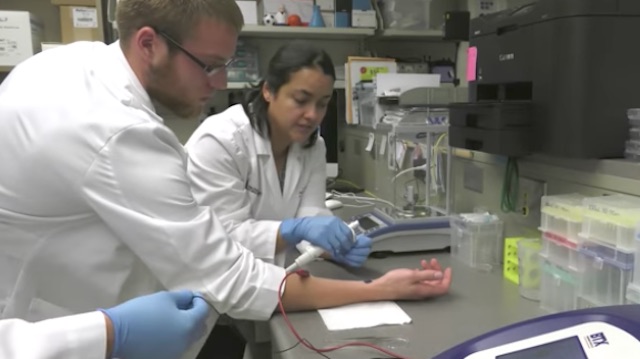
These researchers have created a revolutionary device that can regenerate any kind of body tissue and repair injuries with just a touch to the afflicted area.
The device, which is only about the size of a penny, uses technology known as Tissue Nanotransfection (TNT) to inject genetic code into skin cells, turning those skin cells into any other types of cell required for treating diseased conditions; brain cells, vascular cells, nerve cells – anything a body might need to recover from an injury or sickness can be regenerated with the device.
“It takes just a fraction of a second. You simply touch the chip to the wounded area, then remove it,” said Chandan Sen, director of the Center for Regenerative Medicine and Cell-Based Therapies. “At that point, the cell reprogramming begins.”
In a series of lab tests, researchers from Ohio State University Wexner Medical Center applied the chip to the injured legs of mice that vascular scans showed had little to no blood flow. “We reprogrammed their skin cells to become vascular cells,” Sen said. “Within a week we began noticing the transformation.”
CHECK OUT: First Ever Quadriplegic Treated With Stem Cells Regains Motor Control in His Upper Body
By the second week, active blood vessels had formed, and by the third week, the legs of the mice were saved—with no other form of treatment.
“It extends the concept known as gene therapy, and it has been around for quite some time,” said study collaborator James Lee. “The difference with our technology is how we deliver the DNA into the cells.”
The chip, loaded with specific genetic code or certain proteins, is placed on the skin, and a small electrical current creates channels in the tissue. The DNA or RNA is injected into those channels where it takes root and begins to reprogram the cells.
MORE: New Cancer Drug is So Effective Against Tumors, the FDA Approved It Immediately
In a new study published in Nature Nanotechnology, first author Daniel Gallego-Perez of Ohio State demonstrated that the technique worked with up to 98% efficiency.
“What’s even more exciting is that it not only works on the skin, but on any type of tissue,” Sen said. In fact, researchers were able to grow brain cells on the skin surface of a mouse, harvest them, then inject them into the mouse’s injured brain. Just a few weeks after having a stroke, brain function in the mouse was restored, and it was healed.
Because the technique uses a patient’s own cells and does not rely on medication, researchers expect it to be approved for human trials within a year.
(WATCH the video below)
Multiply The Good: Click To Share With Your Friends



















